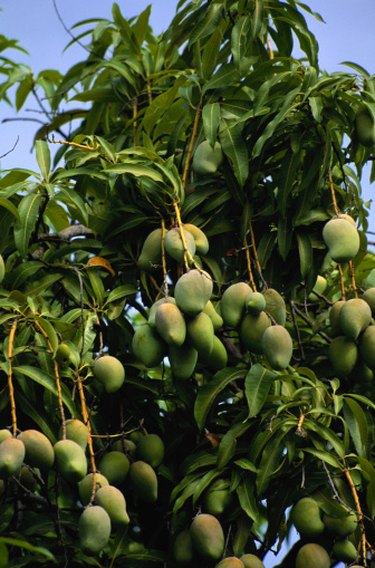
The golden fruit of the mango is an important fruit crop throughout the tropics and sub-tropics. Tropical soils tend to be sandy and lack micronutrients; these are best delivered by spraying them on the mango tree's leaves. When mango tree blossoms are deformed by fungus and bacteria, the conditions can be treated by spraying the tree's developing flower buds. So using the proper foliar (foliage) spray at the right time can ensure a heavier harvest of healthy fruit.
Organic Foliar Feeding
Video of the Day
George Kuepper, a National Center for Appropriate Technology (NCAT) Agriculture Specialist, explains that foliar feeding involves spraying nutrients onto the leaves and stems of a plant and their ability to absorb nutrients at those sites. Effects observed are increased disease resistance, improved drought resistance, yield increases, better uptake of nutrients from the soil, and better fruit quality. The most common organic feeds for mangoes are fish emulsions and seaweed extracts. Sprays made from manure tea, bat guano, worm castings or molasses are used to bolster disease resistance and it is an art to successfully formulate them. An organic mango grower relies on experience when formulating sprays for his mango orchard.
Video of the Day
Nutritional Sprays
Nutritional sprays (which are purchased in liquid form), are mixed with water and applied to the foliage of the mango tree annually to supply it with micronutrients, particularly when it is cultivated in a calcareous soil. "They should contain magnesium, manganese, zinc, boron, and molybdenum," according to horticulturists Jonathan Crane, Carlos Balerdi and Ian Maguire for the University of Florida Ag Extension website. The sprays are applied from March through September. Two to four applications during these months usually are sufficient to supply the mango with all its required micronutrients, according to the website.
Anti-Fungal Sprays
When the buds are forming on the tree is a very critical time in the development of a mango. Fungus and bacteria can form on the bud and transfer to the developing fruit, causing black spot, anthracnose, soft brown rot, and powdery mildew. All of these cause blossom malformation, which affects fruit production. A spray containing copper oxychloride is used on the tree prior to bud formation to combat these diseases and ensure that a good crop will be harvested.
Triazole Sprays
The South Africa Mango Growers Association explains that it is advisable to use triazole fungicides, which act systemically between using sulfur- and copper-based chemicals, to reduce plant resistance to the fungicide. According to the Iowa State Integrated Crop Management website, triazole fungicides inhibit sterol production, which causes abnormal cell growth in the fungus, and it fails to thrive. Triazole sprays are best applied as a preventive measure before the fungal diseases are noted on the mango tree.